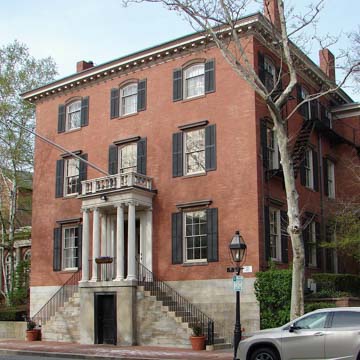You are here
University Club (Rufus and Emily Waterman House)
Across Waterman Street, the University Club began as a two-and-one-half-story Federal house designed by John Holden Greene for Rufus Waterman. The tall stair and porch are his. Rufus's daughter Emily called on Alpheus Morse to blow the house up into an Italian palazzo. Hence the full third story, the modillion cornice, and the low hipped roof. After the University Club acquired the house, in 1900, Stone, Carpenter and Willson enlarged it with a wing to the south, which is most evident in Neo-Federal touches inside. Finally, P. O. Clarke added the Neo-Federal one-story dining wing with its large bow window toward Waterman Street. Although architecturally something of a comfortably elegant mishmash after so much renovation (which is not necessarily a deficit for a club), it holds its triangular site and its front on Benefit Street with distinction.
Writing Credits
If SAH Archipedia has been useful to you, please consider supporting it.
SAH Archipedia tells the story of the United States through its buildings, landscapes, and cities. This freely available resource empowers the public with authoritative knowledge that deepens their understanding and appreciation of the built environment. But the Society of Architectural Historians, which created SAH Archipedia with University of Virginia Press, needs your support to maintain the high-caliber research, writing, photography, cartography, editing, design, and programming that make SAH Archipedia a trusted online resource available to all who value the history of place, heritage tourism, and learning.








